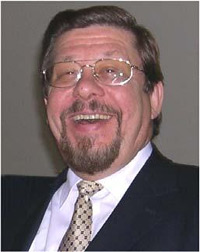
Guenter Schmitt graduated from the Cologne University and Aachen University of Technology in Germany with a Diploma and Ph.D. in Chemistry, a Habilitation + venia legendi in "Chemical Engineering/Technical Chemistry" at the Aachen University of Technology. Assistant Professor in the Institute of Technical Chemistry and Petroleum Chemistry (1978). From 1883 to 1985 full Professor for Technical Chemistry at Ruhr-University of Bochum, Germany. 1986 to 2007 Professor for Corrosion Protection Engineering and Head of the Laboratory for Corrosion Protection at the Iserlohn University of Applied Sciences, Iserlohn, Germany. Additionally, since 2005 CEO and main shareholder of the Institute for Maintenance and Corrosion Protection Technologies (IFINKOR) n.p.Ltd., Iserlohn, Germany.
Guenter Schmitt is actively involved in corrosion technology worldwide as shown below:
Co-Founder, Past President (1995-2004) and Honorary Member (2006) of the German Society for Corrosion Protection (GfKORR); Scientific Chairman of EUROCOR'99; Member of major German associations in the field of Chemistry, Electrochemistry, Chemical Engineering and Corrosion (AGEF, DECHEMA, DGMK, DGO, GDCh, GfKORR, VDI, fkks); Member of international organizations such as ISE, ECS and NACE International (NACE Fellow 2005); Vice Chairman of the International Corrosion Council (2015-2017); Chairman of the International Corrosion Council 2018-2020;
Board Member of the World Corrosion Organization (WCO) since 2018.
Global Needs for Knowledge Dissemination, Research and Development in Materials Deterioration and Corrosion Control
Corrosion has a huge economic and environmental impact on virtually all facets of the world’s infrastructure, from highways, bridges, and buildings to oil and gas, chemical processing, and water and wastewater systems. In addition to causing severe damage and threats to public safety, corrosion disrupts operations and requires extensive repair and replacement of failed assets. The annual cost of corrosion worldwide is estimated to exceed $US 2.2 trillion, which translates to 3 to 4% of the Gross Domestic Product (GDP) of industrialized countries. And about 30% of this sum, i.e. $US 660 billion, could be saved by only applying the present day knowledge.
Highly experienced corrosion professionals are prepared to effectively control the effects of corrosion by using innovative and long-proven technologies when given the proper resources. However, many decision-makers in industry and government do not understand the consequences or extent of corrosion and how critical it is to control it. They also do not appreciate the need for ongoing research and development (R&D) to further reduce the effects of corrosion on people, assets, and the environment.
To raise the awareness about corrosion and corrosion protection around the world and what individuals can do to control it, the World Corrosion Organization (WCO), a non-governmental organization (NGO) at the United Nations (UN) in New York, was founded. With its 35 corrosion associations and societies worldwide, including the International Corrosion Council (ICC), the WCO represents more than 300,000 corrosion scientists, engineers, and technicians from all over the world. In its strategy WCO created an internationally recognized Corrosion Awareness Day, the 24th April.
This paper demonstrates the need to educate the public on the importance of corrosion control, including R&D efforts into such areas as materials development and selection, innovative surface protection systems, and condition-based monitoring using sensors and remote data collection methods. Global standards are also needed to ensure compliance with best practices and share knowledge on effective corrosion control methodologies throughout the world.
Online Corrosion Monitoring in Lab and Field with a New Electrochemical Measuring Tool
The CoulCount-method implemented as a software in a new stand-alone hand-held potentiostat/galvanostat with high data storing capacity represents a new versatile, user-friendly electrochemical tool for online corrosion measurements and monitoring not only in the lab but also directly in the field. The CoulCount-method developed in the presenters institute evaluates electrochemical noise (ECN) signals with an algorithm completely different from traditional ECN analysis. The CoulCount-method translates electrochemical current noise, measured between two metal electrodes in a corrosive environment, directly into corrosiveness levels which after calibration can be directly correlated to corrosion rates. The electrodes are made from the materials to be investigated. Both electrodes can be similar or dissimilar, depending on the corrosion system to be investigated. This makes the CoulCount-method so unique and - together with the hand-held measuring device - opens a huge field of applications for corrosion measurements, testing and real-time corrosion monitoring.
As an example, this paper reports on the application of this method to assess the corrosiveness of soils dfor steel pipelines buried without cathodic protection. Noise current densities are calibrated with corrosion rates obtained from mass loss measurements at four different low alloy steels after exposure in twelve different soils. It is shown that the corrosion performance of low alloy steels in contact with soils can be evaluated within measuring times of 10 to 20 minutes. LPR measurements yielded significantly less reliable information on the corrosion system steel/soil. In combination with the newly developed hand-held potentiostat/ galvanostat with rechargeable battery, ECN measurements with CoulCount-current noise diagnosis can now easily be performed in the field. An experimental setup with a special soil sampling device has been developed which allows CoulCount- measurements directly in a pipeline trench.
This method is recommended in the recently issued DVGW worksheet GW19 (DVGW = German Technical and Scientific Association for Gas and Water). This worksheet builds the basis for rehabilitation planning of supply networks for gas and water distribution in Germany. Efficient planning needs a meaningful failure statistics and a status record on the integrity of the supply network, in order to identify critical parts of the network. For non-cathodically protected pipelines the important criterion for critical parts is the corrosiveness of the soil in which the pipelines are buried. A condition based maintenance could be based a land registry of soil corrosiveness which, however, is no existing. The DVGW worksheet GW19 encourages the use of the CoulCount method as an inexpensive and fast way to evaluate soil corrosiveness and, thus, start to establish a land registry for soil corrosiveness.